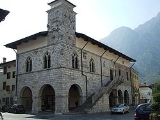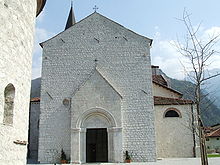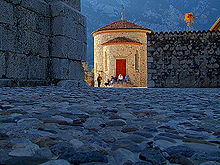
Venzone
Encyclopedia


Comune
In Italy, the comune is the basic administrative division, and may be properly approximated in casual speech by the English word township or municipality.-Importance and function:...
(municipality) in the Province of Udine
Province of Udine
The Province of Udine is a province in the autonomous Friuli-Venezia Giulia region of Italy, bordering Austria and Slovenia. Its capital is the city of Udine....
in the Italian
Italy
Italy , officially the Italian Republic languages]] under the European Charter for Regional or Minority Languages. In each of these, Italy's official name is as follows:;;;;;;;;), is a unitary parliamentary republic in South-Central Europe. To the north it borders France, Switzerland, Austria and...
region Friuli-Venezia Giulia
Friuli-Venezia Giulia
Friuli–Venezia Giulia is one of the twenty regions of Italy, and one of five autonomous regions with special statute. The capital is Trieste. It has an area of 7,858 km² and about 1.2 million inhabitants. A natural opening to the sea for many Central European countries, the region is...
, located about 90 km northwest of Trieste
Trieste
Trieste is a city and seaport in northeastern Italy. It is situated towards the end of a narrow strip of land lying between the Adriatic Sea and Italy's border with Slovenia, which lies almost immediately south and east of the city...
and about 30 km north of Udine
Udine
Udine is a city and comune in northeastern Italy, in the middle of Friuli-Venezia Giulia region, between the Adriatic sea and the Alps , less than 40 km from the Slovenian border. Its population was 99,439 in 2009, and that of its urban area was 175,000.- History :Udine is the historical...
.
History
Venzone is mentioned for the first time in 923 AD as Clausas de Albiciones, and 1001 in a diplom by Otto IIIOtto III, Holy Roman Emperor
Otto III , a King of Germany, was the fourth ruler of the Saxon or Ottonian dynasty of the Holy Roman Empire. He was elected King in 983 on the death of his father Otto II and was crowned Holy Roman Emperor in 996.-Early reign:...
.

Patriarchate of Aquileia (State)
The Patriarchate of Aquileia was an Imperial State in the Friulian region of Northeastern Italy under the control of the Patriarchs of Aquileia.- Foundation :...
in 1336. In 1351 it became part of Austria and, together with the whole Friuli, from 1420 was ruled by the Republic of Venice
Republic of Venice
The Republic of Venice or Venetian Republic was a state originating from the city of Venice in Northeastern Italy. It existed for over a millennium, from the late 7th century until 1797. It was formally known as the Most Serene Republic of Venice and is often referred to as La Serenissima, in...
. After a period under the Austrian domination, it was annexed to the newly formed Kingdom of Italy in 1866.
Venzone was almost entirely destroyed by the earthquake that struck Friuli in 1976, being rebuilt in the following year. The reconstruction has finished in the '90, with the Duomo.
Main sights
- The Duomo (Cathedral), erected by the master Giovanni in 1338. It is a noteworthy GothicGothic architectureGothic architecture is a style of architecture that flourished during the high and late medieval period. It evolved from Romanesque architecture and was succeeded by Renaissance architecture....
edifice with a simple façade with a portal decorated by reliefs of Saints and Christ, a tall bell tower and the apse area with high windows flanked by Gothic pilasters. The southern side has also several mullioned windows. The interior has remains of 14th and 15th century frescoes and decorated capitals. Outside is a small baptistery. - Communal Palace (1390-1410), with a loggia accessible from an external stair.
- The medieval walls

